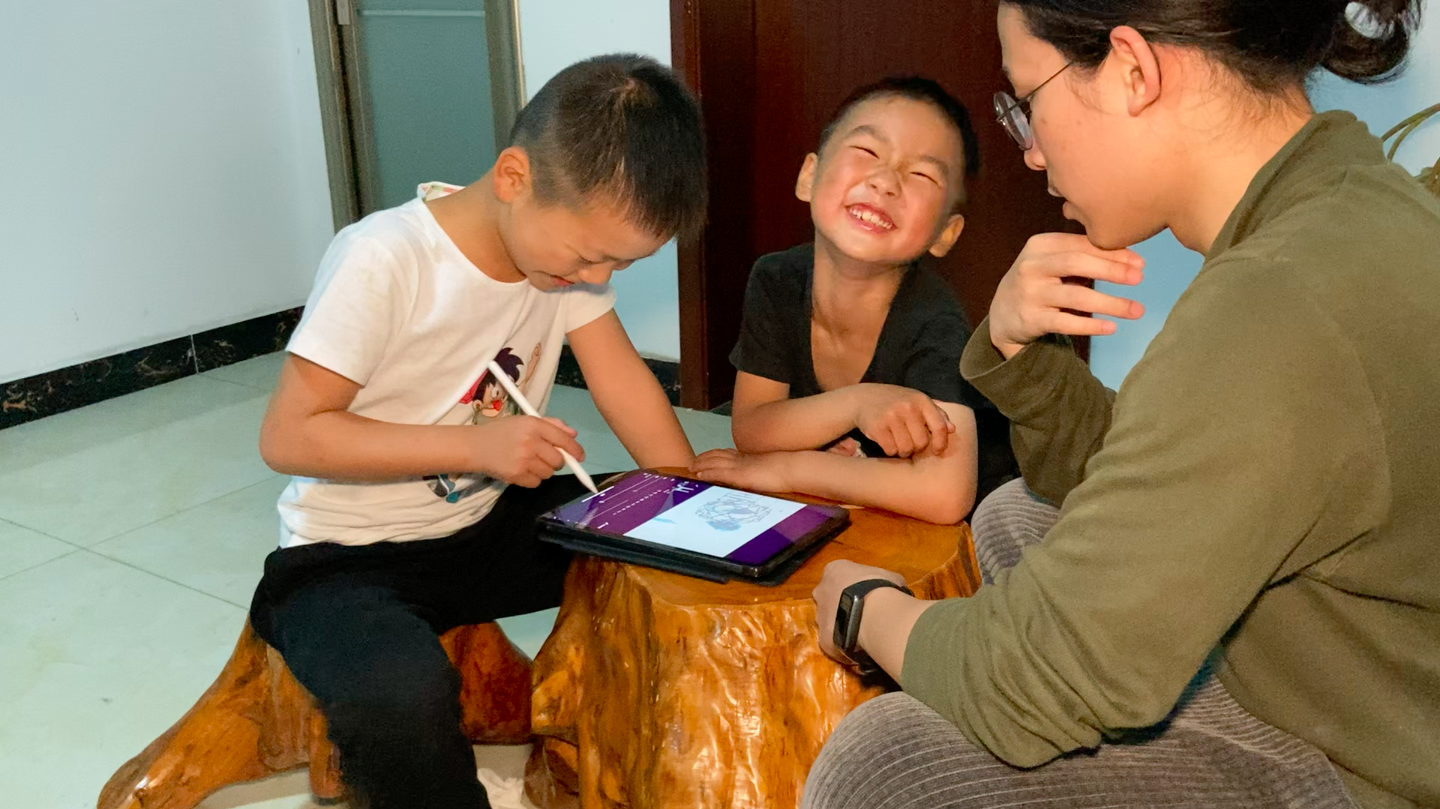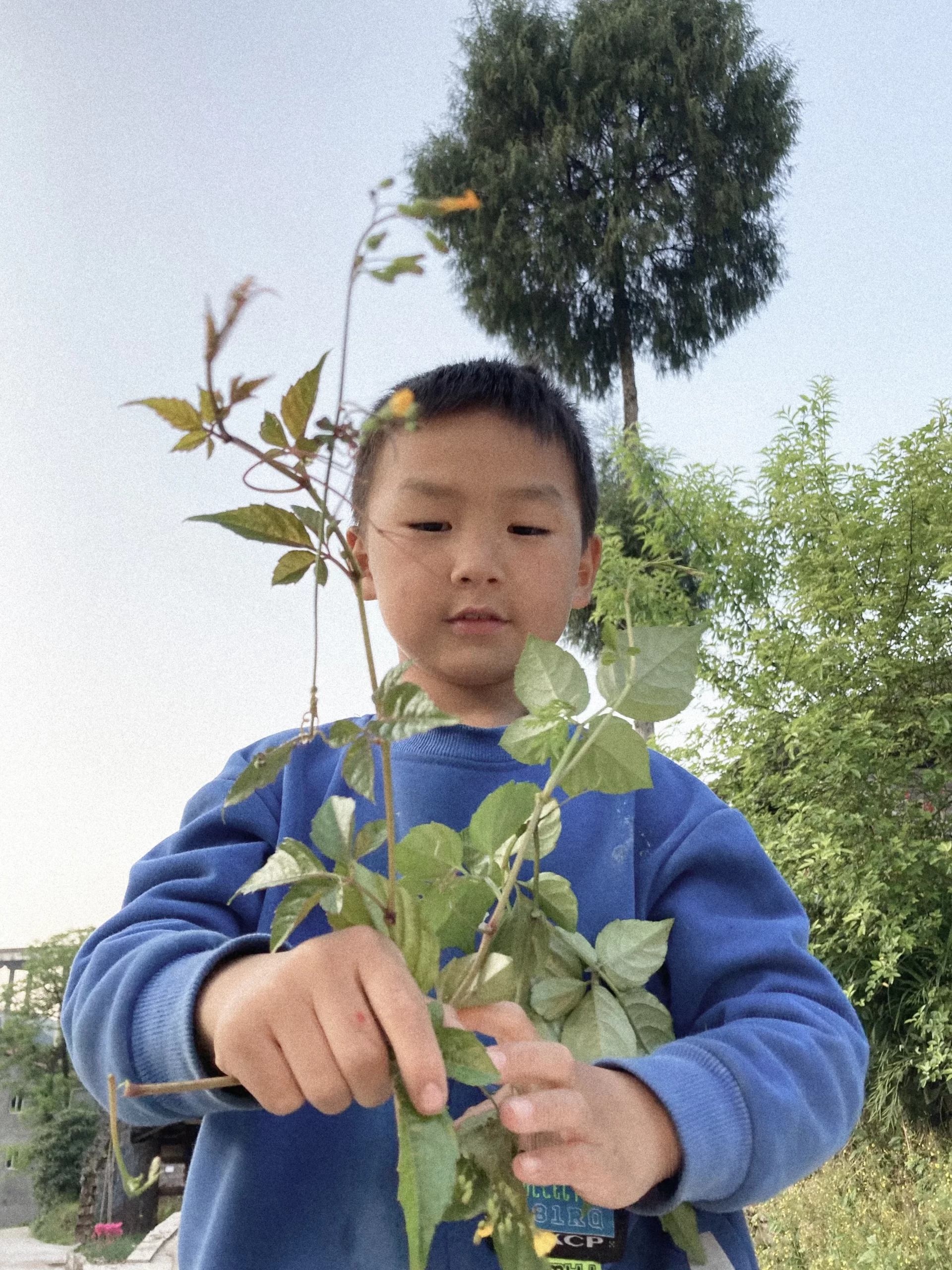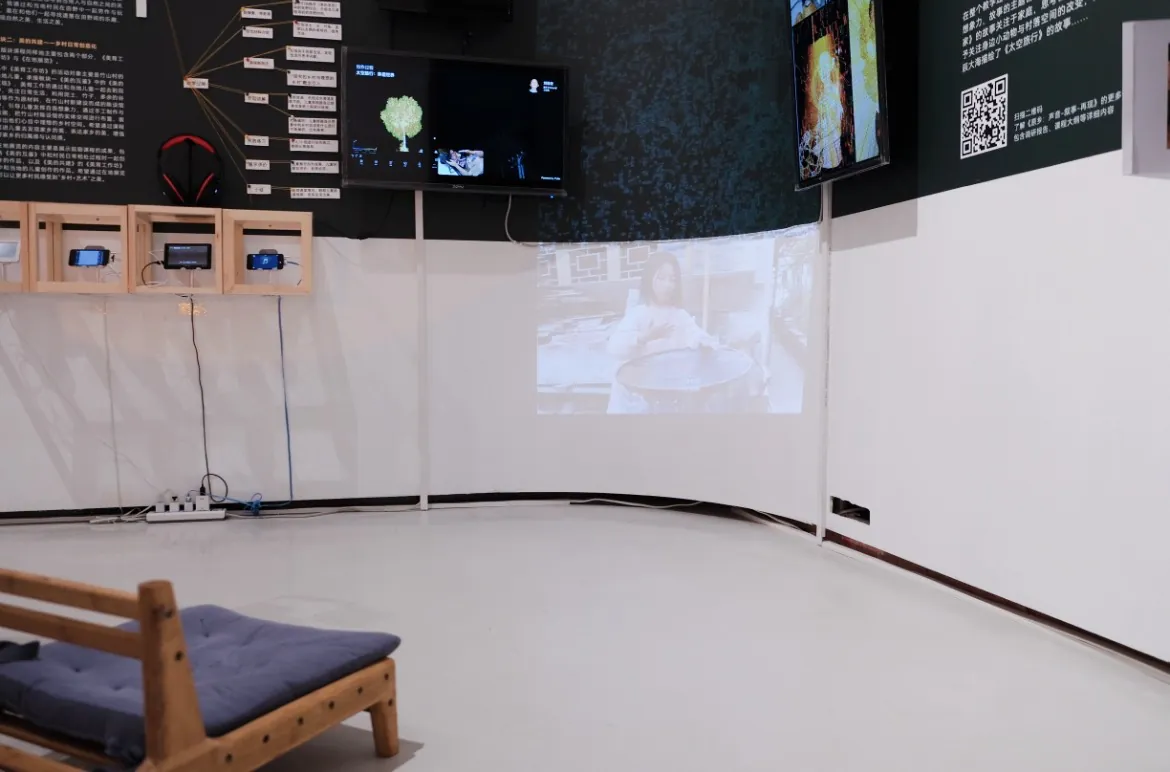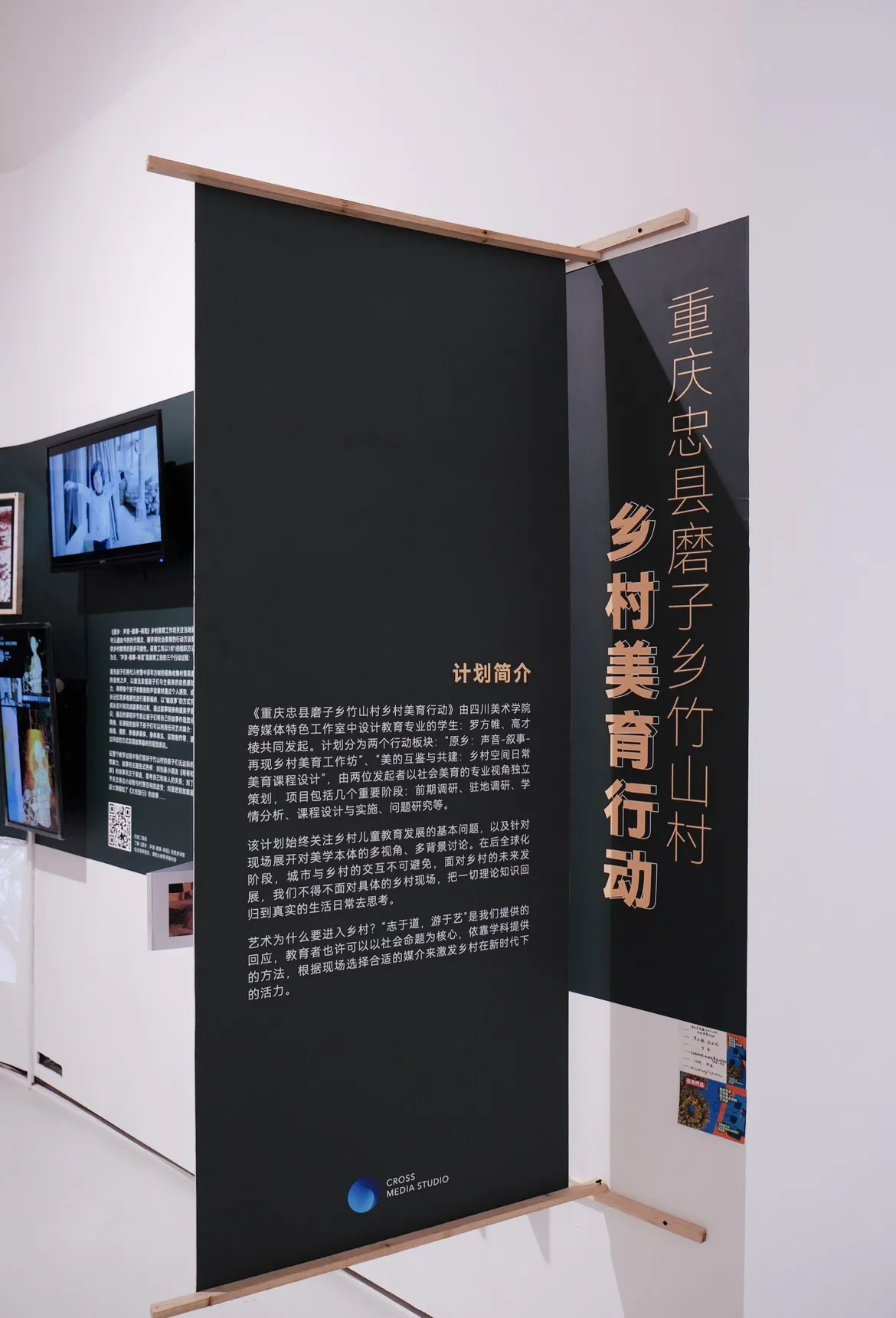原乡:声音·叙事·再现
Homeland: Sound, Narrative, Representation
-
2022
乡村儿童美育工作坊
rural children's aesthetic education workshop
项目地:中国重庆 · 竹山村
Located: Zhushan Village, Chongqing, China

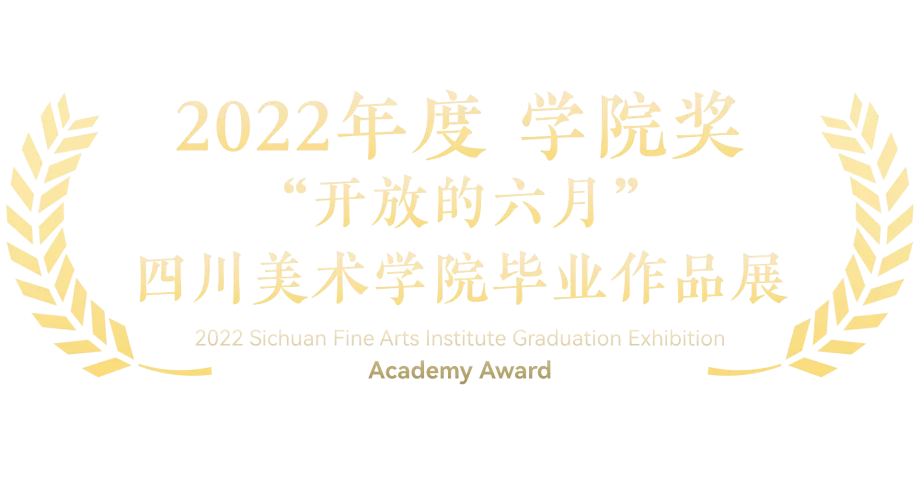
「原乡:声⾳–叙事–再现」乡村美育工作坊的现场位于重庆市忠县磨⼦乡竹山村。放眼望去,竹山村如中国现今千千万万的乡村⼀样,⾯对相似的老龄化、空空化问题,此计划关注当地留守儿童如今的时代境况,期许用社会美育的行动方法提供乡村教育单向度发展的破局可能性。美育工坊以1对1的组织方式为主,“声音-叙事-再现”是美育工坊的三个行动过程:首先孩子们将代入村落中百年古树的视角收集村落周遭的自然之声,以激活发掘孩子们与生俱来的自然感知力;再将每个孩子收集到的声音素材通过个人感知、成长记忆等多维属性进行重新编排,以“编故事”的方式完成从切片到完成叙事的过程,通过叙事链条构建美学意识;最后的课程环节是让孩子们将自己的故事作视觉化转换,在课程的指导下孩子们可以利用任何艺术媒介:绘画、摄影、影像多媒体、身体表达、实物制作等,实现故事最终的视觉表达。
The “Homeland: Sound, Narrative, Representation” rural children’s aesthetic education workshop focuses on the contemporary conditions of left-behind children and explores new possibilities for rural education through aesthetic actions. The workshop is organized in a one-to-one format and is divided into three action processes: Sound, Narrative, and Representation:
- Sound: Children collect natural sounds from the perspective of the village’s century-old trees, activating their innate natural perception.
- Narrative: The collected sound materials are rearranged through personal perception and growth memories in a “storytelling” manner, completing the narrative process and establishing an aesthetic consciousness.
- Representation: Children visually transform their stories using various artistic media such as drawing, photography, and multimedia, achieving a visual expression of their stories.
This workshop not only provides a platform for Zhushan Village’s left-behind children to showcase themselves, explore nature, and express creativity but also offers new insights into the diversified development of rural education.

创作故事及自述:
“乡村当下存在的问题,本质上是因农耕文明正在全方位面对城市文明的冲击而产生。传统乡土社会面临基层社会结构重塑、生态环境改变、本土文化缺失等等问题,只有乡村自身的壮大,才是原乡对抗任何内外部威胁的永久力量。如今中国乡村发展是系统性的从产业、人才、文化、组织、生态多维度进行的振兴发展的新格局。教育者应该在其中找到自己的本位,美作为启迪智慧、打开感知的钥匙,我希望对美的讨论可以不再局限于单一媒介或理论体系之下。这次行动我们看到了一座朴实的农村在现代化过程中的变与不变,期许未来更多人能用更温柔的目光,看到农村的多元价值。”
Creation Story & Self-statement:
“The current problems in the countryside essentially stem from the all-encompassing impact of urban civilization on agricultural civilization. Traditional rural societies face issues such as the reshaping of grassroots social structures, changes in the ecological environment, and the loss of native culture. Only the strengthening of the countryside itself can be a permanent force against any internal or external threats. Nowadays, the development of Chinese villages is systemic, with a new pattern of revitalization and development from multiple dimensions including industry, talent, culture, organization, and ecology. Educators should find their place in this, with beauty serving as the key to enlightening wisdom and opening perception. I hope the discussion of beauty can extend beyond single media or theoretical systems. In this action, we witnessed the simplicity of rural life amidst modernization, hoping that more people in the future can see the diverse values of the countryside with a gentler gaze.”
我以社会美育的专业视角独立策划了“原乡:声音·叙事·在现 乡村儿童美育工作坊”,项目包括几个重要阶段:前期调研、驻地调研、学情分析、课程设计与实施、问题研究等。该计划始终关注乡村儿童教育发展的基本问题,以及针对现场展开对美学本体的多视角、多背景讨论。在后全球化阶段,城市与乡村的交互不可避免,面对乡村的未来发展,我们不得不面对具体的乡村现场,把一切理论知识回归到真实的生活日常去思考。
I independently planned the Workshop of social aesthetic education. The project includes several crucial stages: preliminary research, on-site investigation, analysis of learning conditions, course design and implementation, and problem research. The plan always focuses on the fundamental issues of rural children’s educational development, as well as initiating multi-perspective, multi-background discussions on the ontology of aesthetics at the site. In the post-globalization era, the interaction between urban and rural areas is inevitable. Facing the future development of the countryside, we must confront the specific rural scene directly, bringing all theoretical knowledge back to the reality of daily life for contemplation.”
项目基本信息
本次乡村美育行动将从重庆忠县磨子土家族乡竹山村周边开启。竹山村放眼望去,如中国现今千千万万的乡村一样,面对相似的问题,同时也面临着同样的机遇和挑战。这里的村中心的广场多数时候不热闹,偶尔农忙以后的老伯老太坐在椅子上谈天说地,村落只剩干净、悠然。方圆十几里,没有名胜古迹和名山大川、没有惊险刺激与神奇瑰丽,只有环抱村落的公路和村旁高速路上的车流呼啸。这里的野畜、村庄、田野、溪水,让我们看到一个悠然、质朴、素拙、开阔、恬静的竹山村。
Project Information
This rural aesthetic education action will commence in the vicinity of Zhushan Village, Mozi Tujia Ethnic Township, Zhong County, Chongqing. Looking around Zhushan Village, like countless other villages in China today, it faces similar issues while also encountering the same opportunities and challenges. The village center’s square is mostly quiet, with elders occasionally chatting on chairs after busy farming periods, leaving the village serene and tranquil. Within a radius of several miles, there are no famous historical sites or majestic mountains and rivers, no thrilling adventures or magical beauty, just the highways that encircle the village and the roaring traffic on the nearby expressway. The wild animals, the village, the fields, and the streams show us a Zhushan Village that is serene, simple, unadorned, open, and tranquil.
竹山村位于磨子乡东北部,由原印盒村、竹山村合并而成,幅员面积约2.7平方公里,离磨子场2公里,与忠县乌杨工业园区接壤,G50高速穿越境内。现辖9个村民小组,户籍人口580户、1734人,其中少数民族599人(土家族为主),占比约41.9%。常住人口482人(60岁以上老年人占比为70%-80%,18-59岁常住人口约为70余人),外出务工985人。
Zhushan Village is located in the northeastern part of Mozi Township, formed by the merger of the original Yinhui Village and Zhushan Village, covering an area of approximately 2.7 square kilometers. It is 2 kilometers away from Mozi Field, borders the Wuyang Industrial Park of Zhong County, and is crossed by the G50 highway. The village governs 9 villager groups, with a registered population of 580 households and 1734 people, including 599 ethnic minorities (primarily Tujia), accounting for about 41.9%. The permanent population is 482 people (with 70%-80% over 60 years old, and about 70 people aged 18-59), and 985 people work outside the village.
驻地调研报告
驻地调研从人口结构、产业结构、文化结构、组织结构、生态结构五个方向切入,回应乡村振兴的五大振兴方向。
On-site Research Report
The on-site research approached from five directions: population structure, industrial structure, cultural structure, organizational structure, and ecological structure, responding to the five revitalization directions of rural revitalization.
人口结构
从线上的背景信息调研,到初入竹山村完成乡村驻地的第一阶段。我发现竹山村的人口结构为留守老人和儿童居多,以及部分于区县务工节假日通勤回村的青壮年,整体老龄化较为严重。但从另一个角度我却发现竹山村却诞生了不少高学历人才,以现留守于村落中的老人为第一代,其第二代、第三代家族谱系中,许多人家中都有本科以上的大学生,现多为外地务工。
Population Structure
From online background research to the initial entry into Zhushan Village completing the first stage of rural residency. I found that the population structure of Zhushan Village consists mainly of left-behind elderly and children, as well as some young and middle-aged people who work in the district and county and commute back to the village during holidays, showing a serious overall aging. However, from another perspective, I discovered that Zhushan Village has produced quite a few highly educated talents. Taking the elderly currently left in the village as the first generation, in the genealogy of the second and third generations, many families have university students with undergraduate degrees or higher, most of whom are now working outside the area.

*竹山村现辖9个村民小组,户籍人口580户、1734人,其中少数民族599人(土家族为主),占比约41.9%。常住人口482人(60岁以上老年人占比为70%-80%,18-59岁常住人口约为70余人),外出务工985人。全村党员61名(含驻村工作队成员2名),平均年龄61岁,在家党员24名。2021年2月、2021年4月分别完成村级党组织、村委会换届选举工作。现有村实职干部4人、本土人才1人,大专以上学历3人,平均年龄32岁。综上,在人口结构上,目前竹山村人口外流严重,常住人口仅占户籍人口的27.30%;人口结构老龄化、农村空心化严重,在地多为空巢老人,且年龄大多在60岁以上;儿童大多在乡里或外地上学,周末或者寒暑假也随父母在外地,竹山村在地留守儿童较少。
*Zhushan Village currently governs 9 villager groups, with a registered population of 580 households and 1734 people, including 599 ethnic minorities (primarily Tujia), accounting for about 41.9%. The permanent population is 482 people (with 70%-80% over 60 years old, and about 70 people aged 18-59), and 985 people work outside the village. The village has 61 party members (including 2 members of the village work team), with an average age of 61, 24 of whom are at home. In February and April 2021, the village-level party organization and village committee elections were completed, respectively. There are currently 4 full-time village officials, 1 local talent, 3 people with college education or above, and an average age of 32. In summary, regarding the population structure, Zhushan Village currently suffers from serious population outflow, with the permanent population accounting for only 27.30% of the registered population; the population structure is aging, and rural hollowing out is serious, with many elderly people left behind in the area, mostly over 60 years old; children mostly study in the township or outside areas, spending weekends or vacations with their parents away from the village, resulting in fewer left-behind children in Zhushan Village.
产业结构
青壮年多于区县一级行政单位务工,外地务工者多在云南贵州两地,老人们日常的务农行为已从农业产业退化成为小农自给,作物无稻米,多为经济性作物。
Industrial Structure
Most of the young and middle-aged people work at the district and county level administrative units, with many working in Yunnan and Guizhou provinces. The daily farming activities of the elderly have degenerated from agricultural industry to small-scale self-sufficiency, with no rice crops but mostly economic crops.

*在产业结构上,竹山村产业结构单一,多为附加值较低的种植业,迫切需要外部提供产业支撑。目前,全村产业现以柑橘、西瓜和种猪养殖为主,有柑橘1958亩,德康种猪场占地397亩、存栏父母代种猪2500头,村集体发展西瓜100亩。计划扶持的产业还有中华蜂养殖和小磨香油等。
*In terms of industrial structure, Zhushan Village has a single industrial structure, mostly composed of low-added-value planting industries, urgently requiring external industrial support. Currently, the village’s industry is mainly focused on citrus, watermelon, and pig breeding, with 1958 mu of citrus, Dekang Pig Farm covering 397 mu with a stock of 2500 parent generation breeding pigs, and the village collective developing 100 mu of watermelon. Planned industries for support also include Chinese bee breeding and small mill sesame oil, etc.
文化结构
老一辈重视教育,大多数二代、三代子女都接受过不同程度的教育。七旬老人陪伴孙辈完成家庭作业的场景时时可见。无明显土家族文化表征。
*根据调研组的实地访谈和调研,发现竹山村尤其重视党建引领,开展丰富的主题党史教育和多种形式的党建主题教育活动。竹山村不仅每月开展主题党日活动学党史、上党课,而且还采用多种形式进行党建教育,比如聘请外部专家进行安全急救知识宣讲、院落整理等活动。值得一提的是,竹山村大部分党员年龄都在60岁以上,但其参与党员主题活动的积极性很高,个别80多岁的党员依旧积极参与主题党建活动。
Cultural Structure
The older generation values education, and most of the second and third generations have received various levels of education. Scenes of septuagenarians helping their grandchildren with homework are commonly seen. There are no apparent cultural representations of the Tujia ethnicity.
*According to the field interviews and research by the research team, it was found that Zhushan Village places special emphasis on party building leadership, conducting rich themed party history education and various forms of themed party building educational activities. Not only does Zhushan Village carry out themed party day activities to learn party history and take party classes every month, but it also employs various forms of party building education, such as hiring external experts for safety first aid knowledge lectures, courtyard organizing, etc. It is worth mentioning that most of the party members in Zhushan Village are over 60 years old, but their enthusiasm for participating in themed party activities is high, with some party members over 80 years old still actively participating in themed party building activities.

组织结构
村旁未来将建成党群服务中心,“亲临自然”生态花园共建计划未来将于此地落地完成,将形成周边基层自治、民主治村的样本。
*在村庄管理上,全村依靠村委自上而下的四级网格管理体系进行管理,几乎没有其他村民自组织参与农村自治。据访谈得知,目前竹山村村委使用在地党员设岗定责的方式采用网格化管理进行农村社区治理,自上而下的建立了网格管理长—网格管理员—网格员—村民的四级管理体系。在网格员的选取上,竹山村采用党员+群众结合的方式,选取了16个党员和15个群众进行网格化体系的搭建,并对其进行分配,把网格员分配到各个院落,以点带面的促成院落治理网络的形成,更有效的服务在地村民群体。同时,根据访谈得知,目前网格员主要在生态环境治理、公共设施维护、空巢独居老人关怀、基层矛盾化解、水费收取这几个方面发挥了重要的作用。
Organizational Structure
A Party and Masses Service Center will be built next to the village, and the “Close to Nature” ecological garden co-construction plan will be implemented here in the future, forming a sample of grassroots autonomy and democratic village governance around the area.
*In terms of village management, the entire village relies on a four-level grid management system from top to bottom implemented by the village committee, with almost no other villager self-organization participating in rural autonomy. According to interviews, the Zhushan Village Committee currently employs a grid management approach for rural community governance, using local party members with assigned positions and responsibilities, establishing a four-level management system from grid management head—grid administrator—grid member—villagers. In the selection of grid members, Zhushan Village adopts a combination of party members + masses, selecting 16 party members and 15 masses to construct the grid system, and allocating them to various courtyards, facilitating the formation of a courtyard governance network from points to areas, more effectively serving the local village population. Meanwhile, according to interviews, grid members currently play an important role in ecological environment governance, public facilities maintenance, care for elderly living alone, grassroots conflict resolution, and water fee collection.

生态结构
竹山村印盒组整体位于盆地地势,周边环绕丘陵,公路直通村口,旁有高速公路,汽车呼啸但似乎噪音影响不大。村中有野畜、菜地、田地、溪流。于村广场旁有一株200年左右历史(依据村中老人口述得知)的皂角树,高十余米,树干需三人合抱,此树同时是村中的空间地标。
Ecological Structure
The Yinhe group of Zhushan Village is overall located in a basin terrain, surrounded by hills, with a road leading directly to the village entrance, next to a highway, where cars roar but seem to have little noise impact. The village has wild animals, vegetable gardens, fields, and streams. Next to the village square, there is a Chinese Honeylocust tree with a history of about 200 years (according to the oral account of the elderly in the village), more than ten meters high, requiring three people to embrace, which also serves as a spatial landmark in the village.

课程方案推导
经过驻地调研以及相关案例的横向比对,竹山村是典型的劳动力外流村落,自从中国加入WTO逐渐成为世界工厂后,乡村开始加速向城市单向的输出劳动力,中国乡村出现了的老龄化、空心化等一系列危机。我后来发现威胁中国乡村的不仅是“没有人”,更重要的是人才缺失所导致的农业衰颓、社会解体、环境恶化及本土文化的沦丧等问题。
Curriculum Program Derivation
After on-site research and horizontal comparison with relevant cases, Zhushan Village is a typical example of a village experiencing labor outflow. Since China gradually became the “world’s factory” after joining the WTO, the countryside has started to accelerate its one-way export of labor to cities, leading to a series of crises such as aging and hollowing out in Chinese villages. I later discovered that the threat to Chinese villages is not only the absence of people but more importantly, the decline in agriculture, social disintegration, environmental degradation, and the loss of native culture due to the lack of talent.
我因此最终把目光放在了竹山村的留守儿童身上。竹山村的儿童大多在乡里或外地上学,周末或者寒暑假也随父母在外地,竹山村在地留守儿童实际上数量不多。得益于我国的基础设施建设日趋完善,随着乡村教育的不断发展,磨子乡中心小学目前拥有了良好的基础教育设施。
As a result, I ultimately focused my attention on the left-behind children of Zhushan Village. Most children in Zhushan Village either study in the township or outside areas, spending weekends or vacations with their parents away from the village, leaving actually a small number of left-behind children in Zhushan Village. Thanks to the continuous improvement of our country’s infrastructure and the development of rural education, Mozi Township Central Primary School now has good basic education facilities.
留守儿童的问题不仅是当下的问题,更是未来的问题。
The problem of left-behind children is not only a current issue but also a future concern.
而对于竹山村在地的留守儿童而言,他们将使用乡村的生产生活方式面对城市文明所要求的规模化流程化的基础教育。乡村学校中的基础教育往往容易忽略孩子们的多样性成长诉求。此类教育的最终目的往往只有一个,把所有人“变成”统一要求的“城市人”。
For the left-behind children in Zhushan Village, they will be using the rural production and living style to face the standardized and proceduralized basic education demanded by urban civilization. Basic education in rural schools often tends to overlook the diverse growth needs of children.The ultimate goal of such education often has only one objective: to “transform” everyone into “city people” with uniform requirements.
社会美育也许可以提供一种路径,通过教育真正的实现育人,将自我人格的建构从“单线程”的教育中解放。
Social aesthetic education may provide a path, truly achieving education through enlightening, and liberating the construction of personal character from the “single-threaded” education.
我在调研中发现村中心的百年皂角树是创造和发掘原乡文化的良好切入点,它静静的矗立在村中心,无声的陪伴村里的老中青少三代人成长,它充分的具有时间和空间维度的延展性,我希望能将具象的树变成抽象的象征。通过走访调研、口述历史、趣味问答等方式从村中各个年龄段的人搜集到了皂角树的故事,再将皂角树这一抽象的象征变成具体的、亲近的历史同历者。
In my research, I found that the century-old Chinese Honeylocust tree in the village center is a good entry point for creating and exploring native culture. It stands quietly in the center of the village, silently accompanying the growth of the old, middle, and young generations, fully possessing the extension of time and spatial dimensions. I hope to transform the tangible tree into an abstract symbol. Through visits, oral histories, and fun quizzes, I collected stories about the Chinese Honeylocust tree from people of all ages in the village, turning this abstract symbol into a concrete, approachable co-traveler through history.

教学板块介绍
美育其最重要的作用之一是让一个人更有尊严与幸福地活着。
根据案例研究、驻地调研后,我通过系列课程的设计,从孩子的美学认识、空间感知、叙事能力等多元角度切入。同时选择转变教学思维,将自己的身份从美的教育者调整为美的学习者,把美的解释权还给孩子们,和孩子们一起交流,去探索乡村的美,相信结合他们自身的经历更能诠释出独到的美的理解。《原乡:声音–叙事–再现》乡村美育工作坊,通过自然向大自然倾听,成为讲故事的人的方式,建构孩子们从自然到生活的全序列的美学意识。
Teaching Module Introduction
One of the most important roles of aesthetic education is to allow a person to live with more dignity and happiness.
After on-site research and horizontal comparison with relevant cases, I found that Zhushan Village is a typical village experiencing labor outflow. Since the development of modern urbanization, the countryside has been accelerating its one-way export of labor to cities, leading to issues like aging and hollowing out in Chinese villages. The departure of young people for work in cities has resulted in a large number of left-behind children in the countryside. Based on case studies and on-site research, I have designed a series of courses from multiple perspectives, including children’s aesthetic recognition, spatial perception, and narrative ability. At the same time, I chose to transform the teaching mindset, adjusting my role from an educator of beauty to a learner of beauty, returning the right to interpret beauty to the children, communicating with them to explore the beauty of the countryside, believing that combining their own experiences can better articulate a unique understanding of beauty.The “Homeland: Sound, Narrative, Representation” rural aesthetic education workshop, through listening to nature and becoming storytellers, constructs a full sequence of aesthetic consciousness for children from nature to life.
教学方案
美育工坊以1对1的组织方式为主,「声音-叙事-再现」是参与孩子们审美成长的具体方法。
Teaching Plan
The aesthetic education workshop is mainly organized in a one-on-one manner, with “Sound-Narrative-Representation” being the specific method for participating children’s aesthetic growth.
「声音」是听觉的语言,是富有的穿透力、想象力的媒介,声音有助于打开孩子们与生俱来的自然感知,通过声音提供重新观看乡村生活方式。
“Sound” serves as the language of hearing, a medium rich in penetration and imagination, helping to unlock the children’s innate natural perception, and providing a fresh perspective on rural life through sound.
在「叙事」的教学环节中,声音碎片通过“讲故事”的方式成为完整的叙事链条,根据每个孩子们独特的成长经验和个体感知,我们可以看到各式各样饱含童趣、脑洞大开的奇妙叙事。
In the “Narrative” teaching phase, sound fragments become complete narrative chains through storytelling, reflecting the unique growth experiences and individual perceptions of each child, revealing a variety of imaginative and childlike narratives.
「再现」意图将孩子们在创造叙事的过程所产生的美学经验通过媒介的力量进行更深探索。孩子们自己创造的故事可以使用任意的艺术媒介完成视觉化呈现,不论是绘画、摄影、身体表达还是实物制作等,鼓励孩子们使用任何他们所见所想所及的方法完成创作。
“Representation” aims to further explore the aesthetic experiences generated in the narrative creation process through the power of media. The stories created by the children can be visually represented using any artistic medium, whether it be drawing, photography, physical expression, or object creation, encouraging children to use any method they can imagine to complete their creations.
课程提要
课程根据「声音-叙事-再现」分为三个授课阶段,分别开办多次小型驻地乡村美育工作坊,以1对1的组织方式为主,工坊对象为村落中的留守儿童。以参与者为课程设计之本,在工坊课程的第二、第三阶段根据儿童的年龄段、综合特长、认知范围等针对性设计个性化教学。
Course Summary
The course is divided into three teaching stages based on “Sound-Narrative-Representation,” with several small-scale rural aesthetic education workshops held in residency, primarily organized in a one-to-one manner, targeting the left-behind children in the village. The participants are the core of the curriculum design, and personalized teaching plans are made during the second and third stages of the workshop according to the children’s age, comprehensive talents, and cognitive range.
前置准备
在进入正式的教学环节之前,根据驻地走访调研的结果,确认工作坊的参与者。在此过程中了解不同参与者的基本家庭状况、受教育信息、生活状态、日常学习情况等。
在了解参与者的基本信息后,进行开放式教学关系的搭建,通过各式各样孩子们感兴趣的生活、学习话题展开真诚交互,成为跨龄好友。在完成开放式教学关系的搭建后在孩子们眼里我是一个有趣好玩的大哥哥,而不是“学校派来村里的老师”,以此实现教学过程中互鉴共创、美美与共的愿景。
Preliminary Preparation
Before entering the formal teaching phase, the participants of the workshop are confirmed based on the results of the on-site visits and research. During this process, basic family conditions, education information, living status, and daily learning situations of different participants are understood.
After understanding the basic information of the participants, an open teaching relationship is established, engaging in sincere interactions through a variety of life and learning topics that interest the children, becoming cross-age good friends. After establishing the open teaching relationship, in the children’s eyes, I become an interesting and fun “big brother,” rather than a “teacher sent by the school to the village,” thus realizing the vision of mutual inspiration and co-creation, and sharing beauty in the teaching process.
第一阶段
引导参与者情景代入皂角树的视角,收集村落周边大树可能“听到”的声音,在此阶段中充分培养发掘参与者与生俱来的自然感知力,收集的声音可以是:鸡鸭狗鸟的吠鸣、溪水清涧的潺潺、村广场上村民们摆龙门阵洋洋盈耳等等。
在该教学阶段中,根据不同年龄段的孩子具体的实操教学手段将略有不同:当参与者处于拥有较强电子设备使用学习能力的年龄段时,将鼓励指导参与者自行使用录音设备,全程独立完成声音的采集工作,我仅以情景引导的方式作基础课程铺垫;当参与者年龄段较小无法独立操作电子设备时,则充分发挥孩子们在这个年龄段的活力,我将展开深度情景引导,尽可能的激发孩子们的想象力和行动力,同时使用电子设备跟拍记录孩子们的所听所见。
First Stage
Guide participants to empathize with the perspective of the Chinese Honeylocust tree, collecting sounds that the trees around the village might “hear.” In this stage, fully cultivate and explore the participants’ innate natural perception, collecting sounds such as the barking and chirping of chickens, ducks, dogs, birds, the babbling of streams, and the lively atmosphere of villagers setting up dragon dance formations in the village square, etc.
In this teaching stage, the specific hands-on teaching methods will vary slightly depending on the children’s age groups: when participants are at an age with a strong ability to use electronic devices for learning, they will be encouraged and guided to use recording equipment independently for the entire sound collection process, with me laying the foundation of the course through scenario-based guidance. When participants are too young to operate electronic devices independently, I will fully utilize the energy of children at this age, engage in deep scenario guidance to stimulate their imagination and initiative as much as possible, while using electronic devices to track and record what the children hear and see.
在后期复盘中我发现,此教学阶段中不同年龄段的孩子就已经开始展现了完全不同的关注趋向。有些孩子的关注点超越了周边的生态环境,有些孩子关注点则在于如何更好的使用设备获得更纯净动听的声音……
In the retrospective analysis, I found that children of different ages had already begun to show completely different focuses of attention during this teaching stage. Some children’s focus surpassed the surrounding ecological environment, while others were concerned with how to use the equipment better to capture purer and more pleasant sounds…
第二阶段
第二部分的课程,引导每个参与者将收集的声音素材通过个体感知、成长记忆等多维属性进行重新编排,共同通过“编故事”的方式,构成声音的主题性叙事。
在该教学阶段中,教师的参与及参与方式是重中之重。每个孩子具有全然不同的特点和兴趣所在,一个好的故事/主题没有也不应该有量化的标准答案,教师的教学重点在基于孩子们无限的可能和想象中,鼓励发散思考、打破思维边界,帮助孩子们找到那一个最适合自己的故事和主题。
Second Stage
The second part of the course guides each participant to reorganize the collected sound materials through individual perception, growth memory, and other multi-dimensional attributes, jointly creating thematic narratives of sound through “storytelling.”
In this teaching stage, the teacher’s participation and method of involvement are crucial. Each child has entirely different characteristics and interests, and a good story/theme should not and does not have a quantitative standard answer. The teaching focus is on encouraging divergent thinking, breaking mental boundaries based on the children’s limitless possibilities and imagination, helping them find the story and theme that best suits them.
第三阶段
第三部分的课程,参与者们可以任意利用绘画、摄影、身体表达、实物制作等媒介,把自己的故事作视觉化转换。
在该教学阶段中,教师需要鼓励孩子们使用任何他们所见所想所及的方法完成创作,同时明确自身专业技术指导的身份,在孩子们面对自身感兴趣但是又从未接触过、带有怯意的艺术媒介时,应及时对孩子的选择表示肯定,并手把手的带领孩子进入这一媒介,鼓励其独立的完成更多探索。
Third Stage
The third part of the course allows participants to freely use mediums such as drawing, photography, physical expression, and object creation to visually translate their stories.
In this teaching stage, teachers need to encourage children to use any method they can imagine and see to complete their creations, while also clearly defining their role as a guide in professional and technical skills. When children face artistic mediums they are interested in but have never encountered before and are apprehensive about, teachers should affirm the children’s choices promptly and lead them into these mediums hands-on, encouraging them to independently explore further.
在整个教学过程中我们惊讶于竹山村的孩子们无边际的想象力,故事的主题各式各样:参与工作坊的其中一个孩子的故事主题是《太空旅行》,在简单的指导后,他能够通过摄影、后期特效等艺术手法表达自己对外星世界和宇宙的理解,上过几次课后甚至他可以完全脱离指导,独立的将自己的想象力通过艺术的语言落实。未受标准化训练的创作体现了孩子们的童趣和纯真;异于工业化大生产和钢铁森林的成长环境也给予了孩子们独特的审美经验。这些都是时代照耀之下珍贵发光的宝藏。
在许多人的印象中乡村小学往往意味着“不发达”、“欠发展”,乡村教育发展的困境依旧存在,但随着大多数乡村的基础设施建设完善,在忠县竹山村,孩子们能够拥有良好的学习环境和接受较好的基础教育。这也提醒了笔者,其实中国乡村的留守儿童并不是一味的落后于城市里的孩子,教育者在美育行动时应该警惕自己下意识的“好或者坏”的二元评判标准;乡村与城市有着完全不同的生产生活方式,不同孩子的成长经验应该同样被尊重。
One of the children participating in the workshop chose “Space Travel” as their story theme. With some basic guidance, they were able to express their understanding of outer space and the universe through photography and post-production effects. After a few lessons, they could even independently translate their imagination into the language of art without guidance. The unstandardized creation reflects the children’s playfulness and innocence; their growth environment, distinct from industrial mass production and steel jungles, has provided them with unique aesthetic experiences. These are precious treasures illuminated by the era.
In many people’s impressions, rural elementary schools often signify “underdeveloped” or “underdeveloped,” and the difficulties in the development of rural education still exist. However, with the improvement of infrastructure in most villages, in Zhushan Village, Zhong County, children can have a good learning environment and receive better basic education. This also reminds the author that left-behind children in rural China are not inherently behind urban children. Educators in aesthetic education actions should be wary of their subconscious “good or bad” binary standards of judgment; rural and urban areas have completely different production and living styles, and the growth experiences of different children should equally be respected.

作品展廊 Exhibition of Works
结语
从城乡二元化结构到乡村哺育城市,输送人力和物资,导致乡村空心化,美育在这其中的作用是可以提升村民的幸福感,让村庄留得住人,有人才能治理好乡村,才能实现乡村振兴。本次的乡村美育行动旨在以点带面,通过典型教学案例的打造,为竹山村在地留守儿童社群通过艺术文化的语言建立文化共同体,以文化组织的方式编织在地留守儿童间的多元关系。在本次美育行动中,笔者组织竹山村里的留守儿童以村落古树为主题共同创作,为未来的竹山村振兴的重要参与者率先重拾原乡文化自信,以艺术的创新方法感悟个体与原乡的关系,留下珍贵的成长印记。本次乡村美育行动期许能通过文化理想的播种,促进参与者身心的健康发展,优良价值观的养成,以实现留守儿童族群内部良续的互助成长平台的构建。
同时本次研究和实践难免存在局限性:基于行动成本的限制,在地的推广力度不足,没有把美育课程更系统性的推广和适用到更大的范围内,研究和行动仅局限于竹山村,没有能够在有限的时间内打开横向的研究广度;在笔者离开后,对孩子们未来的美育课程规划探索不足,没能与在地的相关组织(如学校、村委会等)建立好高效稳定的联系方法和反馈机制……。
如今中国乡村发展是系统性的从产业、人才、文化、组织、生态多维度进行的振兴发展的新格局。在未来,笔者将持续以教育者的视角观察乡村的发展、以及留守儿童的处境,结合艺术的语言在其中找到自己的本位。美作为启迪智慧、打开感知的钥匙,笔者希望未来对美的讨论可以不再局限于单一媒介或理论体系之下。这次行动我们看到了一座朴实的农村在现代化过程中的变与不变,期许未来更多人能用更温柔的目光,看到农村的多元价值。
Conclusion
From the dual structure of urban-rural to rural nurturing cities, supplying labor and materials, leading to rural hollowing out, the role of aesthetic education in this process is to enhance the happiness of villagers, retain people in the village, as only with people can the rural areas be well governed and rural revitalization be achieved. This rural aesthetic education action aims to lead by example, through the creation of typical teaching cases, to establish a cultural community for the local left-behind children community in Zhushan Village through the language of art and culture, and to weave diverse relationships among local left-behind children in the form of cultural organization. In this aesthetic education action, the author organized the left-behind children in Zhushan Village to create together with the ancient trees of the village as the theme, to regain the cultural confidence of the native land for the important participants of the future revitalization of Zhushan Village, to perceive the relationship between the individual and the native land through innovative artistic methods, leaving precious growth imprints. This rural aesthetic education action hopes to promote the healthy development of the participants’ body and mind, the cultivation of excellent values, and to achieve the construction of a good mutual aid growth platform within the left-behind children group through the sowing of cultural ideals.
At the same time, this research and practice inevitably have limitations: due to the limitations of action costs, the promotion efforts on-site are insufficient, and the aesthetic education curriculum has not been more systematically promoted and applied to a broader scope. The research and action are only limited to Zhushan Village and have not been able to open the horizontal breadth of research within a limited time; after the author leaves, there is insufficient exploration of the future aesthetic education curriculum planning for the children, and effective and stable contact methods and feedback mechanisms with local related organizations (such as schools, village committees, etc.) have not been established…
Today, the development of rural China is a new pattern of revitalization and development systematically from the dimensions of industry, talent, culture, organization, and ecology. In the future, the author will continue to observe rural development and the situation of left-behind children from an educator’s perspective and find their own position in it with the language of art. As art serves as the key to enlightening wisdom and opening perception, the author hopes that future discussions on beauty will not be limited to a single medium or theoretical system. In this action, we have seen a simple countryside in the process of modernization, and we hope that more people will see the diverse values of the countryside with a gentler gaze in the future.




